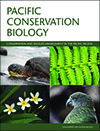Work-related poor mental health is a common but largely unrecognised phenomenon among conservation biologists and ecologists. Among a suite of possible solutions, one way of managing poor mental health is for scientists to reposition their experiences within an historical framework that sees them as part of a long tradition of struggle to protect the natural environment by people from many walks of life. A serviceable guide to the recommended approach is Pablo Casals’ declaration ‘The situation is hopeless. We must take the next step’.
PC21059 Abstract | PC21059 Full Text | PC21059PDF (1.8 MB) Open Access Article





